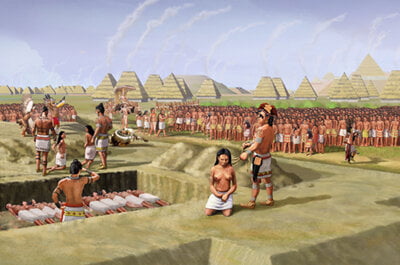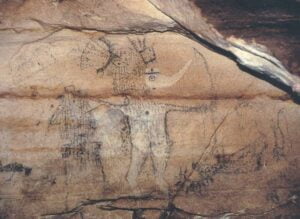Human Sacrifices at Cahokia Mounds
The people of Cahokia practiced human sacrifice. Excavations in 1967 uncovered a mass burial on the site of Mound 72. Around 280 skeletons were uncovered. Around 80% of the bodies were young women. They were placed in neat rows, without signs of trauma. They were likely killed by strangulation or blood-letting.

exc-5e309e3ba761ff54b7654eda
Near the Mississippi River, mounds built by the Mississippian people, tower over the floodplains. The mounds are the remnants of a civilization that built cities along the Mississippi River and its tributaries. Cahokia mounds near East St. Louis, IL, was the largest Mississippian settlement. It was also the largest city north of the Meso-American metropolises of the Aztecs, Mayans, and Olmecs. Like Meso-American cultures, the Mississippian culture was adept in agriculture, astronomy, trading, pottery making and more.
Mound 72
The people in Cahokia also practiced human sacrifice. Excavations in 1967 uncovered a mass burial on the site of Mound 72. Around 280 skeletons were uncovered. Around 80% of the bodies were young women. They were placed in neat rows, without signs of trauma. They were likely killed by strangulation or blood-letting.
In a separate pit, there are around 40 men and women bodies. They were killed by violent means, including decapitation, arrow wounds, and horrific fractures. Evidence shows some dug their nails into the soil, suggesting they were buried alive. Archeologists speculate they were prisoners of war or objectors to human sacrifice practices.
The Birdman
The most prominent burial at Cahokia was “the Birdman.” He was a high-ranking member of the city’s society, maybe even an early ruler. (He wasn’t sacrificed). He was placed under a bed of more than 20,000 marine shell disc beads arranged in the shape of a bird. He was also buried with copper plates, arrowheads, and other goods from throughout the country, reflecting the city’s economic reach. The bird-man motif is common in Mississippian culture and later Native American cultures as a warrior symbol. However, some think the warrior depiction is false and represents fertility instead. Another man was buried below the “Birdman.”
Mound 96, adjacent to Mound 72, is also a burial mound. But federal laws prevent the excavation of buried Native American bodies.
Cahokia eventually collapsed under a multitude of circumstances, including deforestation, sanitary conditions, flooding, and some theorized warfare.
Sources: https://news.illinois.edu/view/6367/391694
http://westerndigs.org/victims-of-human-sacrifice-at-cahokia-were-locals-not-captives-study-finds/
https://cahokiamounds.org/new-discoveries-from-cahokias-beaded-burial/




Just to note, new evidence suggests that flooding was not a significant issue at Cahokia during its occupation.
https://www.msn.com/en-ca/news/us/why-was-the-ancient-city-of-cahokia-abandoned-new-clues-rule-out-one-theory/ar-BB1fzVXp?ocid=msedgntp